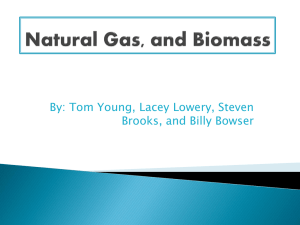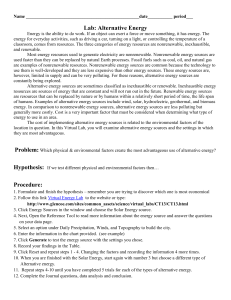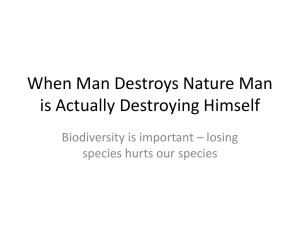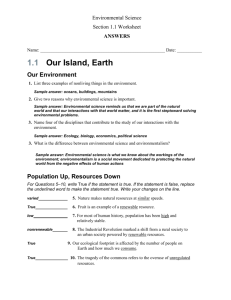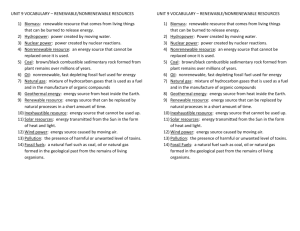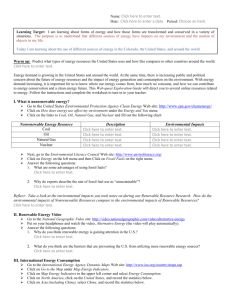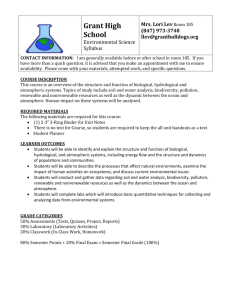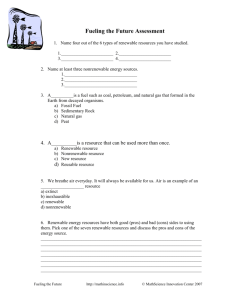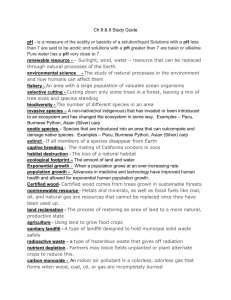Grade 3
advertisement
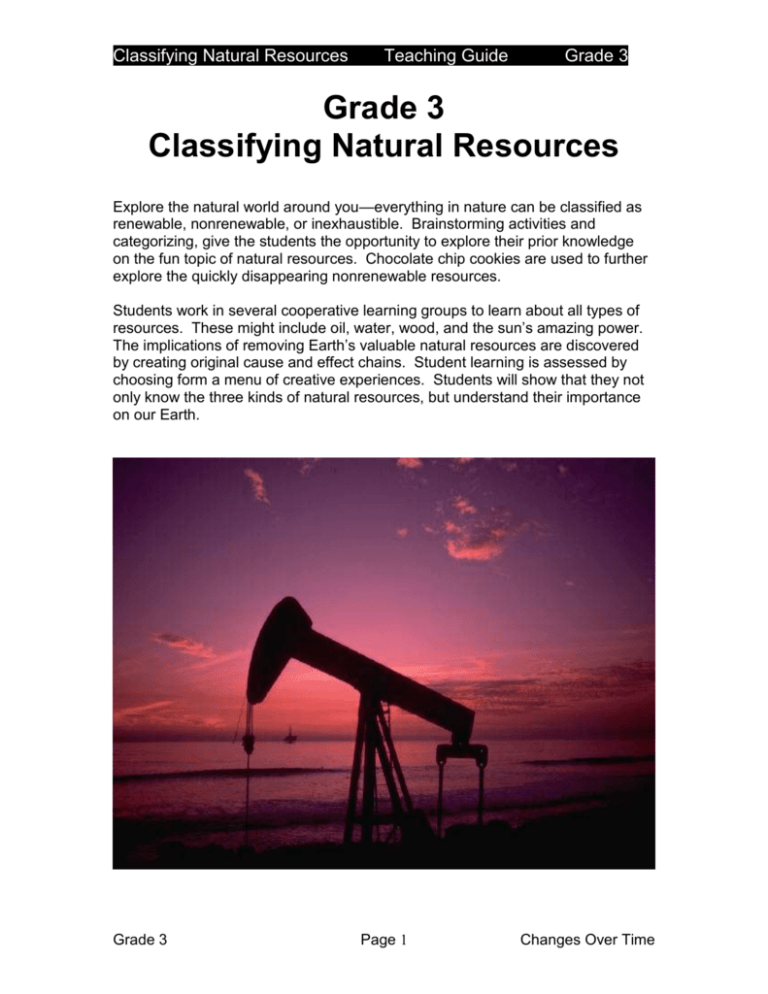
Classifying Natural Resources Teaching Guide Grade 3 Grade 3 Classifying Natural Resources Explore the natural world around you—everything in nature can be classified as renewable, nonrenewable, or inexhaustible. Brainstorming activities and categorizing, give the students the opportunity to explore their prior knowledge on the fun topic of natural resources. Chocolate chip cookies are used to further explore the quickly disappearing nonrenewable resources. Students work in several cooperative learning groups to learn about all types of resources. These might include oil, water, wood, and the sun’s amazing power. The implications of removing Earth’s valuable natural resources are discovered by creating original cause and effect chains. Student learning is assessed by choosing form a menu of creative experiences. Students will show that they not only know the three kinds of natural resources, but understand their importance on our Earth. Grade 3 Page 1 Changes Over Time Classifying Natural Resources Teaching Guide Grade 3 3.11 The student knows that the natural world includes earth materials and objects in the sky. The student is expected to: (A) Identify and describe the importance of earth materials including rocks, soil, water, and gases of the atmosphere in the local area and classify them as renewable, nonrenewable, or inexhaustible resources. Explore Engage TEKS Overview of Learning Experiences Students brainstorm resources that are natural. Students sort the brainstormed resources into in to categories titled: Resources that will out, Resources that will come back after being used, and Resources that can never run out. Students relate their prior knowledge of nonrenewable resources to “mine” chocolate from a cookie. Students record and calculate the obtained “energy” they were able to mine from their particular cookie. Evaluate Elaborate Explain Grade 3 Students work in cooperative groups to rotate through several stations where they will read books related to various natural resources. Students analyze each book and cooperatively complete a book review answering several questions about the types of resources mentioned in the books. Students apply their knowledge of natural resources to sort several examples of resources into categories named renewable, nonrenewable, or inexhaustible. Students further apply their knowledge by creating a cause and effect chain using “What if…” statements. Students choose from several evaluation ideas to demonstrate understanding of the three types of natural resources. Page 2 Changes Over Time Classifying Natural Resources Teaching Guide Grade 3 Targeted Texas Essential Knowledge & Skills Science TEKS 3.1 The student conducts field and laboratory investigations following home and school safety procedures and environmentally appropriate and ethical practices. The student is expected to: (A) demonstrate safe practices during field and laboratory investigations 3.2 The student uses scientific inquiry methods during field and laboratory investigations. The student is expected to: (A) plan and implement descriptive investigations including asking welldefined questions, formulating testable hypotheses, and selecting and using equipment and technology; (B) collect information by observing and measuring (C) analyze and interpret information to construct reasonable explanations from direct and indirect evidence; (D) communicate valid conclusions; (E) construct simple graphs, tables, maps, and charts to organize, examine and evaluate information. 3.3 The student knows that information, critical thinking, and scientific problem solving are used in making decisions. The student is expected to: (C) represent the natural world using models and identify their limitations 3.4 The student knows how to use a variety of tools and methods to conduct science inquiry. The student is expected to: (A) collect and analyze information using tools including calculators, microscopes, cameras, safety goggles, sound recorders, clocks, computers, thermometers, hand lenses, meter sticks, rulers, balances, magnets, and compasses 3.11 The student knows that the natural world includes earth materials and objects in the sky. The student is expected to: Grade 3 Page 3 Changes Over Time Classifying Natural Resources Teaching Guide Grade 3 (A) Identify and describe the importance of earth materials including rocks, soil, water, and gases of the atmosphere in the local area and classify them as renewable, nonrenewable, or inexhaustible resources. Language Arts TEKS 3.1 Listening/speaking/purposes. The student listens attentively and engages in a variety of oral language experiences. The student is expected to: (A) determine the purposes for listening such as to get information, to solve problems, and to enjoy and appreciate. (C) participate in rhymes, songs, conversations, and discussions (D) listen critically to interpret and evaluate 3.3 Listening/speaking/audiences/oral grammar. The student speaks appropriately to different audiences for different purposes and occasions. The student is expected to: (A) choose and adapt spoken language appropriate to the audience, purpose, and occasion, including use of appropriate volume and rate (C) ask and answer relevant questions and make contributions in small or large group discussions (E) give precise directions and instructions such as in games and tasks (F) clarify and support spoken ideas with evidence, elaborations, and examples 3.4 Listening/speaking/communication. The student communicates clearly by putting thoughts and feelings into spoken words. The student is expected to: (A) use vocabulary to describe clearly ideas, feelings, and experiences (B) clarify and support spoken messages using appropriate props, including objects, pictures, and charts 3.7 Reading/variety of texts. The student reads widely for different purposes in varied sources. The student is expected to: (B) read from a variety of genres for pleasure and to acquire information from both print and electronic sources Grade 3 Page 4 Changes Over Time Classifying Natural Resources Teaching Guide Grade 3 (C) read to accomplish various purposes, both assigned and self-selected 3.8 Reading/vocabulary development. The student develops an extensive vocabulary. The student is expected to: (A) develop vocabulary by listening to and discussing both familiar and conceptually challenging selections read aloud (B) develop vocabulary through reading 3.17 Writing/grammar/usage. The student composes meaningful texts applying knowledge of grammar and usage. The student is expected to: (D) compose sentences with interesting, elaborated subjects 3. 18 Writing/writing processes. The student selects and uses writing processes for self-initiated and assigned writing. The student is expected to: (A) generate ideas for writing by using prewriting techniques such as drawing and listing key thoughts (B) develop drafts (C) revise selected drafts for varied purposes, including to achieve a sense of audience, precise word choices, and vivid images 3.20 Writing/inquiry/research. The student uses writing as a tool for learning and research. The student is expected to: (B) record his/her knowledge of a topic in a variety of ways such as by drawing pictures, making lists, and showing connections among ideas (C) record his/her knowledge from relevant sources such as classroom guests, books, and media sources Mathematics TEKS 3.11 Measurement. The student selects and uses appropriate units and procedures to measure length and area. The student is expected to: (A) estimate and measure lengths using standard units such as inch, foot, yard, centimeter, decimeter, and meter Grade 3 Page 5 Changes Over Time Classifying Natural Resources Teaching Guide Grade 3 3.12 Measurement. The student measures time and temperature. The student is expected to: (A) tell and write time shown on traditional and digital clocks (B) use a thermometer to measure temperature 3.13 Measurement. The student applies measurement concepts. The student is expected to measure to solve problems involving length, area, temperature, and time. 3.14 Probability and statistics. The student solves problems by collecting, organizing, displaying, and interpreting sets of data. The student is expected to: (C) use data to describe events as more likely, less likely, or equally likely. 3.15 Underlying processes and mathematical tools. The student applies Grade 3 mathematics to solve problems connected to everyday experiences and activities in and outside of school. The student is expected to: (C) select or develop an appropriate problem solving strategy, including drawing a picture, looking for a pattern, systematic guessing and checking, acting it out, making a table, working a simpler problem, or working backwards to solve a problem 3. 16 Underlying processes and mathematical tools. The student communicates about Grade 3 mathematics using informal language. The student is expected to: (A) explain and record observations using objects, words, pictures, numbers, and technology 3.17 Underlying processes and mathematical tools. The student uses logical reasoning to make sense of his or her world. (A) make generalizations from patterns or sets of examples and nonexamples Social Studies TEKS 3.5 Geography. The student understands the concepts of location, distance, and direction on maps and globes. The student is expected to: Grade 3 Page 6 Changes Over Time Classifying Natural Resources Teaching Guide Grade 3 (B) use a scale to determine the distance between places on maps and globes Art TEKS 3. 1 Perception. The student develops and organizes ideas from the environment. The student is expected to: (A) identify sensory knowledge and life experiences as sources for ideas about visual symbols, self, and life events 3.2 Creative expression/performance. The student expresses ideas through original artworks, using a variety of media with appropriate skill. The student is expected to: (A) develop artwork based on personal observations and experiences (C) produce drawings, paintings, prints, constructions, ceramics, and fiber art, using a variety of art materials appropriately Grade 3 Page 7 Changes Over Time Classifying Natural Resources Teaching Guide Grade 3 Interdisciplinary Connections Mathematics Recording Data Interpreting data Using number sentences to perform calculations Art Creation of models and artworks Organize and categorize information in charts and tables Classifying Natural Resources Grade 3 Social Studies Locating and naming the natural resources in a given area. Map skills Page 8 Language Arts Listening and speaking Writing Vocabulary advancement Changes Over Time Classifying Natural Resources Teaching Guide Grade 3 Background Information for Teachers Resources are the supplies of useful or valuable things from which we make or obtain things we need or want. Everything must come from something else; resources are those things with which we begin. Many of our resources are materials from nature. Energy sources can also be classified as resources. Some of these sources are materials and some are not. For example, energy from the sun, which is vital to life on Earth, cannot be physically touched. Coal, on the contrary, on which our society depends so readily on, is physically extracted from the Earth’s surface. Resources are classified as renewable, nonrenewable, or inexhaustible. Renewable resources are those materials that can be replaced in a relatively short period of time. Resources that can form or accumulate over a long time span, such as fossil fuels, are considered nonrenewable. Resources, such as the sun’s energy, which cannot be used up by human activities, are considered to be an inexhaustible resource. Renewable resources are those resources that reproduce themselves. They can include trees, crops, grasses, water, animals, and soil. All living plants use the sun’s energy, carbon dioxide, and water in the process of photosynthesis to make their own food. Plant materials are renewable because more plants can be grown. While careful farming and forestation are necessary for the health of the plants, they can nevertheless be replenished. It is also the sun’s energy, which provides the Earth with the water cycle. It evaporates water from the Earth’s surface so that it may once again fall back in some form of precipitation. Humans use the energy of water in many ways. It is used to power large turbines providing electricity and turn the wheels on paddleboats to help propel them forward. Water can also be heated to form steam, which is used to move trains and run early engines. Animals have many uses. They provide us with food, recreation, and companionship. Since animals have the ability to reproduce and create new animals, they too are considered renewable. Soil is the composition of eroded rocks and organic material such as animal wastes and plant debris. Soil is continually replenished through the erosion and deposition of rocks and through the Nitrogen Cycle, which replenishes soil’s nutrients through animal wastes and decay. Almost all of the total energy we use in this country comes from nonrenewable resources, mainly the fossil fuels – coal, oil, and natural gas. These resources are referred to as “fossil” fuels because they were formed over long periods of time from buried prehistoric plants and animals. The energy stored in these fuels originally comes from the sun’s energy through the process of photosynthesis that took place in the lifetime of these organisms. Even though the process of photosynthesis is continuing even today, fossil fuels are still considered nonrenewable, because the formation of the energy source is too slow for us to foresee a renewed supply in the near future. Another nonrenewable resource Grade 3 Page 9 Changes Over Time Classifying Natural Resources Teaching Guide Grade 3 are minerals such as metals and rocks. There are no more minerals being formed, so when we take them from the Earth, we are using irreplaceable resources. Inexhaustible resources are those that are continuous and always available for human use. The sun’s energy, which will be available for approximately another 5 billion years, provides the needed energy for the wind. The sun powers the wind by heating different air masses, which then move about the Earth’s atmosphere. We capture this wind in the form of windmills, which can pump water or generate electricity in some areas. The gravitational pull of the moon, which is also never ending, powers the ocean’s tidal system. The ocean’s tides are considered an inexhaustible resource because the power behind the tides— the gravitational pull of the moon, is continuous. Grade 3 Page 10 Changes Over Time Classifying Natural Resources Teaching Guide Grade 3 Engage Materials: Package of post it notes per group of 4 students 4 large posters per class 1. Divide the class into groups of four students. Write the words “Natural Resources” on the first poster board. Remind the students that “Natural” is anything that comes from nature or is not man-made. Allow the kids to brainstorm within their groups things that are considered “natural.” Tell the students to write these things on the post it notes and place them on the poster board. If needed, remind the students that some things in nature are not seen, but only felt. (i.e. wind and sun) Once finished, remove any repeated resources from the poster board. 2. Title the remaining posters, “Resources that will run out,” “Resources that will come back after being used,” and “Resources that can never run out.” Invite one group at a time to move a post it note from the Natural Resources poster to one of the three remaining resources posters. Continue inviting the groups until all post it notes have been moved from the Natural Resources poster. 3. Read aloud the post it notes from each of the three posters. Ask the students if they disagree with any of the post it notes. If there are disagreements, hold a class discussion until there is a common consensus among the class. If needed, lead the students to the following conclusions: Resources that will run out (natural gas, fossil fuels, and minerals), Resources that will come back (Plants, animals, and soil), and Resources that will never run out (Solar energy, tidal energy, and wind energy). 4. Finally, give each of the three posters a name. “Resources that will run out” should be labeled Nonrenewable. “Resources that will come back after being used” should be labeled Renewable. “Resources that can never run out” should be labeled Inexhaustible. Practice creating sentences that use the new name and the definition. The sentences should be as follows: Grade 3 Renewable resources are resources that will come back after being used. Nonrenewable resources are resources that will run out. Inexhaustible resources are resources that will never run out. Page 11 Changes Over Time Classifying Natural Resources Teaching Guide Grade 3 Explore Materials: 1 soft chocolate chip cookie per student 1 toothpick per student 1 bowl or paper towel per student 1 student data sheet 1. Explain to the students that you will be completing an activity using a chocolate chip cookie. However, the chocolate chip cookie will represent land with nonrenewable resources such as coal, oil, or natural gas buried inside. Their job then is to remove the resource so that it can be used as an energy source. 2. Provide each student with a chocolate chip cookie, toothpick, paper towel or bowl, and a student data sheet. Explain to the students that each chip they are able to remove with the toothpick is worth 5 days of energy. Broken chips may be combined as 1 whole chip. Explain that it is important that their “land” be kept as much in tact as possible. The goal is to obtain as much energy as possible from their “land,” while also keeping the “land” as intact as possible. Also explain that the students should record all data on the student data sheet. 3. While the students are working, actively monitor to ensure the students are keeping their “land” in tact, and accurately recording their data. When the students have had ample time to manipulate the materials, ask the students the following: Grade 3 What is the cookie a model of? (land) What do the chocolate chips represent? (fossil fuels) Why must we dig carefully to remove the chips? (to protect the land) Why is it important to protect the land? (The land may be a home for humans or animals…accept all reasonable answers) What did the land look like after we removed the chips? (It had holes where the chips once were) Once we removed the chips, will they come back? (no) What kind of resource do the chips represent? (nonrenewable) Why do the chips represent a nonrenewable resource? (Because nonrenewable resources are resources that do not come back after being used, and the chocolate chips will not come back after we removed them from the cookie.) Page 12 Changes Over Time Classifying Natural Resources Student Page Name_________________ Grade 3 Date_______________ Chocolate Mining Draw an illustration of your cookie before mining the chocolate. What does the cookie represent? What does the chocolate represent? How many chips were you able to mine from the cookie? Use the following number sentence to calculate the total number of days of energy you gained from your chocolate. _____________ X 5 DAYS # of chocolate chips = ______________ # of total days of energy Draw an illustration of your cookie after mining the chocolate. What kind of resource does the chocolate represent? Why does the chocolate represent that kind of resource? Grade 3 Page 13 Changes Over Time Classifying Natural Resources Teaching Guide Grade 3 Explain Materials: 1 set of resource cards per student 1 copy OIL by Christian Ditchfield per class 1 copy of COAL by Christian Ditchfield per class 1 copy of WATER by Christian Ditchfield per class 1 copy of WOOD by Christian Ditchfield per class 1 copy of Facts on Water, Wind, and Solar Power by Guy Arnold per class 1 copy of Student Book Review sheet per student Glue for every student 1. Divide the students into 5 groups. Explain to the students that they will be working cooperatively in groups. They will be rotating through 5 books which they will read as a group and then work together to complete the Student Book Review. Allow plenty of time for all students to rotate through every station and have ample time to read and complete the review sheet. 2. Once every student has completed every station, gather the students again as a class. Explain to the students that they will now be using the information from the books to complete a card sorting game. Give each student a set of resource cards and explain that they should cut and glue the cards in the correct order so that each illustrated resource is underneath the correct resource heading. Allow ample time for all students to complete the sorting and gluing. 3. Once the students have completed the sorting, ask the following: Grade 3 Which resources are underneath the renewable heading? (Plants, animals, water, and soil) Which resources are underneath the nonrenewable heading? (Oil, minerals, coal, and natural gas) Which resources are underneath the inexhaustible heading? (Wind, Sunlight, Oxygen, and ocean tides) Page 14 Changes Over Time Classifying Natural Resources Student Page Grade 3 Renewable Nonrenewable Inexhaustible Plants Soil Minerals Animals Oil Wind Water Natural Gas Sunlight Oxygen Coal Ocean Tides Grade 3 Page 15 Changes Over Time Classifying Natural Resources Student Page Name__________________________ Grade 3 Date__________ Student Book Review 1. What are natural resources? 2. What is a nonrenewable resource? 3. What is a renewable resource? 4. What is an inexhaustible resource? 5. What kind of resource is oil? 6. What kind of resource is water? 7. What kind of resource is wood? 8. What kind of resource is wind? 9. What kind of resource is coal? 10.Predict what kind of resource tides will be. Grade 3 Page 16 Changes Over Time Classifying Natural Resources Teaching Guide Grade 3 Elaborate Materials: 5 Sentence strips per student Stapler 1. Explain to the students that they will create a cause and effect chain. Each student will receive 5 sentence strips. The student will write a “What if there were/was no more …… (Complete with a natural resource) on their first sentence strip. An example might be: What if there was no more water. On the second strip the student will then write the result of the “what if...” statement. An example might be: There would be no more evaporation. On the third, the student will write the result of the second statement. An example might be: There would be no more rain. The student will continue writing the results of the previous statements until all sentence strips are used. 2. Explain to the students they need to now illustrate each effect on the end of the sentence strip. The students will then loop the sentence strips together to make a chain of cause and effect statements. Allow the students to share their cause and effect statements with their classmates. Grade 3 Page 17 Changes Over Time Classifying Natural Resources Teaching Guide Grade 3 Evaluate Materials: Several old magazines per student Scissors and glue Large construction paper 1. Explain to the students they will choose from several “menu” choices for their final assessment. 2. The first, being to create a Natural Resource Collage. They will look through several old magazines for pictures of natural resources. After cutting the picture out of the magazine, the student will glue it on a section of the construction paper they have marked as either, Renewable, Nonrenewable, or Inexhaustible. Some of the pictures may be duplicated as long as they are represented differently. For example: a bottle of water and a swimming pool with water in it. 3. The second menu choice will be to create an original flipbook. The flipbook will use two pieces of construction paper folded together to form 3 flaps and a cover. The cover should be titled Natural Resources and the three flaps: Renewable, Nonrenewable, and Inexhaustible. Explain that the inside of the booklet should clearly show that they know what each type of resources is and that they know several examples of each. 4. The last menu choice is to create an original song or skit. The piece should demonstrate that they know the three types of resources and can give several examples of each. Grade 3 Page 18 Changes Over Time Classifying Natural Resources Teaching Guide Grade 3 Reading Connection Bringing the Rain to Kapiti Plain, Verna Aardema. Beatriz Vidal. Dial Books, 1981. Kapiti Plain is in serious need of water, and Ki-pat, the herdsman, finds a way to bring down the rain. Folk-art illustrations and a catchy, rhythmic "this-is-thehouse-that-Jack-built" text make this a popular read-aloud book. Listeners can take parts in the book and be involved in the retelling of the story. Oak Tree, Gordon Morrison. Houghton Mifflin, 2000. A year in the life of a grand oak tree is depicted through detailed pencil and watercolor paintings, expressive text, and explanatory margin notes. The ecology of the tree as a host for a number of small creatures is explained. Old Elm Speaks: Tree Poems, Kristine O'Connell George. Kate Kiesler. Clarion Books, 1998. Original tree poems full of imagery and description are complemented by rich, warm oil painting illustrations. This volume forgoes humor to focus on poetry, including free verse, rhyme, and haiku She's Wearing a Dead Bird on her Head!, Kathryn Lasky. David Catrow. Hyperion Press, 1995. This fictionalized account explores the birth of the Massachusetts Audubon Society at the end of the nineteenth century. Harriet Hemenway and Minna Hall, two proper Bostonians, were cofounders of the Massachusetts organization that had an impact on the bird-protection movement. The female activists in the story serve as strong female role models for today's students. The charming and humorous illustrations are watercolors and ink. When Birds Could Talk and Bats Could Sing: The Adventures of Bruh Sparrow, Sis Wren, and Their Friends Virginia Hamilton. Barry Moser. Scholastic, 1996 . Eight bird and animal stories are retold based on African American tales originally written down by Martha Young on her father's plantation in Alabama after the Civil War. Large watercolor illustrations bring added warmth and humor to the stories. Grade 3 Page 19 Changes Over Time Classifying Natural Resources Teaching Guide Grade 3 Reference Energy Wheel Teacher Information. www.fsec.ucf.edu.htm Grade 5 TAKS Science Information Booklet Illinois State Museum Geology Online. http://geologyonline.museum.state.il.us LessonPlansPage.com Natioanl Education Standards. www.nap.edu/readingroom.html Women In Mining. www.womeninmining.com Grade 3 Page 20 Changes Over Time
